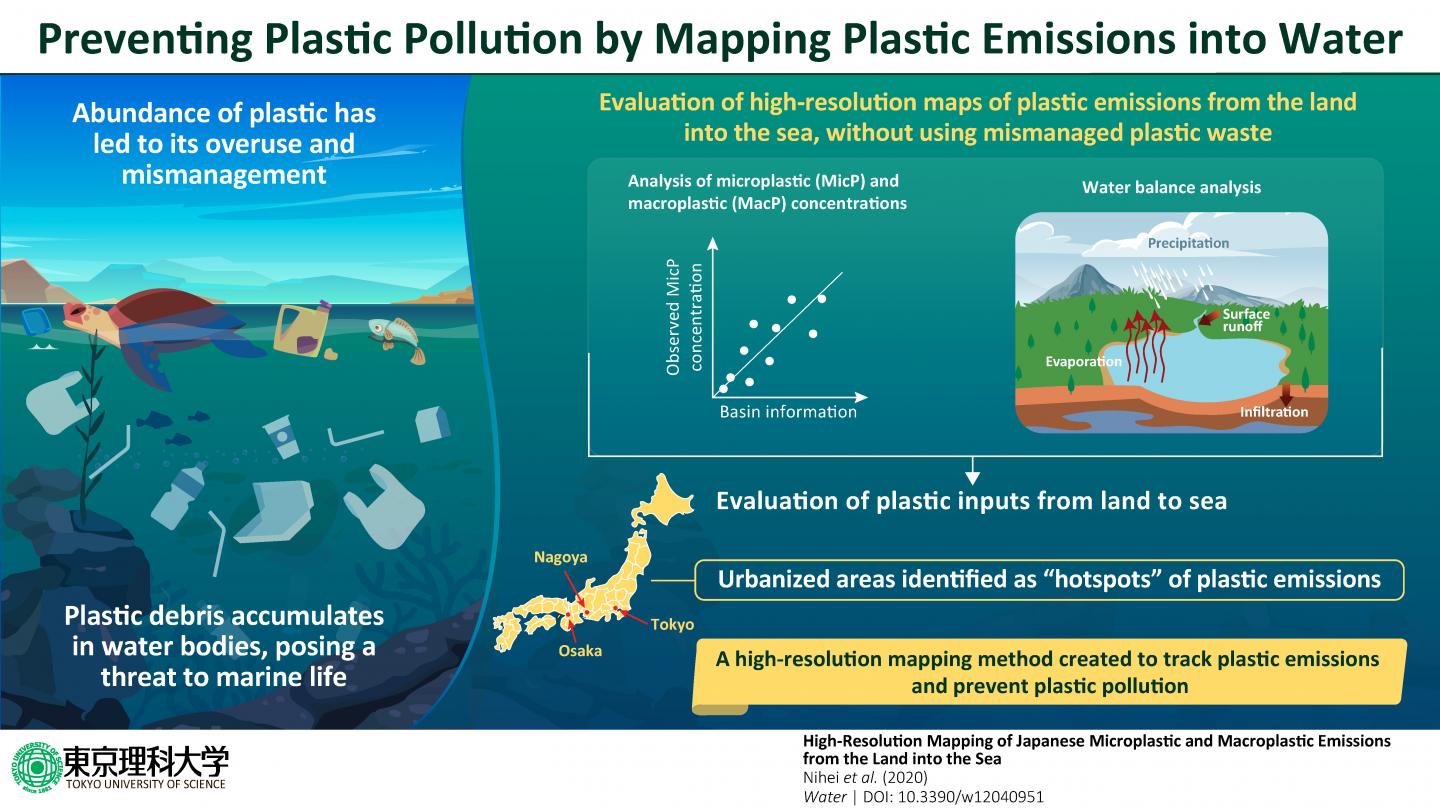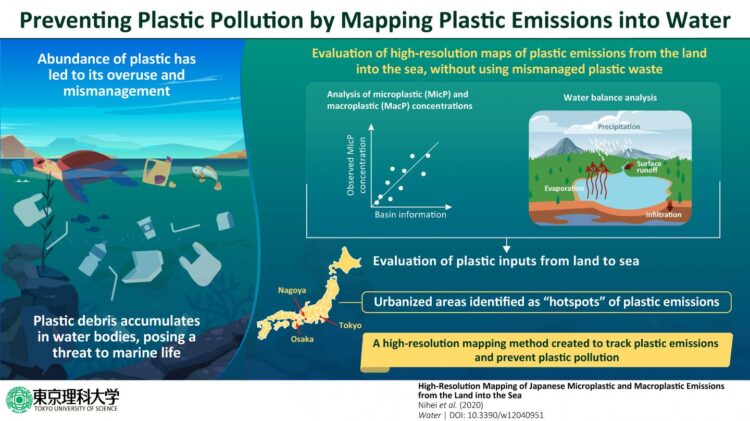Scientists in Japan develop a new method to track plastic emissions from land to sea

Credit: Tokyo University of Science
Plastic may be an indispensable part of our daily lives, but its robustness and abundance have led to its overuse, putting a huge burden on the environment. Large emissions of plastic waste result in its accumulation in water bodies: in fact, recent studies have estimated about 0.27 million tons of plastic floating in the world’s oceans. Because plastic does not decompose in water, it is a serious hazard for the marine life. Thus, to prevent plastic pollution, it is crucial to understand exactly how plastic is emitted into the oceans. Previous studies have tried to analyze plastic emissions, but they had some limitations: they focused on mostly mismanaged plastic waste and not how these plastic emissions actually originate.
To this end, a group of scientists at the Tokyo University of Science, led by Prof Yasuo Nihei, developed a new method to combat plastic emissions. In a study published in Water, they generated a “high-resolution map of 1 km grids of plastic emissions across Japan. Prof Nihei explains, “If plastic waste continues to flow into the sea, the amount of plastic waste will increase. To prevent this, it is necessary to clearly indicate where and how plastic debris is currently being generated.“
To begin with, the scientists focused on the different types of plastics: microplastic (MicP), which is less than 5 mm in size, and macroplastic (MacP), which is greater than 5 mm. They understood that controlling MicP was crucial because–owing to its small size–it is particularly hard to recover once it enters the ocean. Moreover, it can easily be ingested by marine organisms, which can negatively affect ecosystems worldwide. To avoid the emission of MicP in water bodies, it was important to find out exactly where these emissions were coming from.
The scientists followed a three-step process to map plastic emissions (Figure 1). First, they measured MicP concentration across 70 rivers and 90 sites in Japan and examined the relation between MicP concentration and land characteristics. They collected the ratio of MacP/MicP concentrations to evaluate the MacP concentration from the MicP concentration. Next, to obtain outflow discharge at 1 km grids, they performed a “water balance analysis” in which they measured precipitation of water, distributed into three categories: evaporation, surface runoff, and underground infiltration. Finally, they calculate total plastic emission, which is the product of MicP and MacP concentrations and outflow discharge. Their findings revealed that MicP concentrations and basin characteristics were significantly correlated, meaning that the physical features of water bodies dictate the amount of plastic waste accumulated. Not just this, their analysis helped the scientists to estimate the annual plastic emission in Japan, which ranged from 210 to 4,776 tons/year of total plastic.
The scientists then evaluated a high-resolution map of plastic emission over 1 km grids across Japan (Figure 2). They identified the critical areas where plastic emissions were the highest. Their analysis showed that these emissions were high in rivers near urbanized areas, with a high population density. Among these, cities like Tokyo, Nagoya, and Osaka were found to be hotspots for plastic emissions. Thus, this method was useful in understanding exactly where strict countermeasures should be enforced.
Unlike previous studies, this study does not assume that the plastic waste is only proportional to mismanaged plastic waste but, in fact, takes into account the origin of plastic emissions. This makes it easier to implement measures and curb plastic emissions in specific areas. Prof Nihei concludes, “Our findings provide new insights that may be used to draft countermeasures against plastic emissions, thereby reducing outflow of marine pollutants from Japan. We also introduce a new method that can be used to evaluate plastic inputs in other regions of the world.“
###
About The Tokyo University of Science
Tokyo University of Science (TUS) is a well-known and respected university, and the largest science-specialized private research university in Japan, with four campuses in central Tokyo and its suburbs and in Hokkaido. Established in 1881, the university has continually contributed to Japan’s development in science through inculcating the love for science in researchers, technicians, and educators.
With a mission of “Creating science and technology for the harmonious development of nature, human beings, and society”, TUS has undertaken a wide range of research from basic to applied science. TUS has embraced a multidisciplinary approach to research and undertaken intensive study in some of today’s most vital fields. TUS is a meritocracy where the best in science is recognized and nurtured. It is the only private university in Japan that has produced a Nobel Prize winner and the only private university in Asia to produce Nobel Prize winners within the natural sciences field.
Website: https:/
About Professor Yasuo Nihei from Tokyo University of Science
Dr Yasuo Nihei is a Professor in the Department of Civil Engineering, Tokyo University of Science. After completing his graduation at Tokyo Institute of Technology, he has now been working at Tokyo University of Science since 2000. A respected and senior researcher, his research interests include hydraulic engineering, with a focus on computational fluid mechanics and environmental hydraulics. He is the corresponding author of this paper and has over 170 research publications and 3 patents to his credit.
Funding information
This research was supported by the Japan Society for the Promotion of Science under the KAKENHI program (grant no. 17H04937), the River Fund of the River Foundation (grant no. 2019-5211-050), and the Tokyo University of Science Grant for President’s Research Promotion.
Media Contact
Tsutomu Shimizu
[email protected]
Related Journal Article
http://dx.





